Women’s Fashion from 1900 to 1919
The previous century had produced crinolines, bustles, polonaises, dolmans, abundant frills and furbelow’s of every description. But the new century, at the height of the Belle Epoch ( beautiful era) was bowing to simplicity and to common sense. Though details were still elaborate, fussy trimmings and unnatural lines were gradually being abandoned.
This trend of simplicity was enormously intensified and sped up by the The Great War, which clearly established two great principles in women’s dress — freedom and convenience.
The Belle Epoch – Age of Opulence
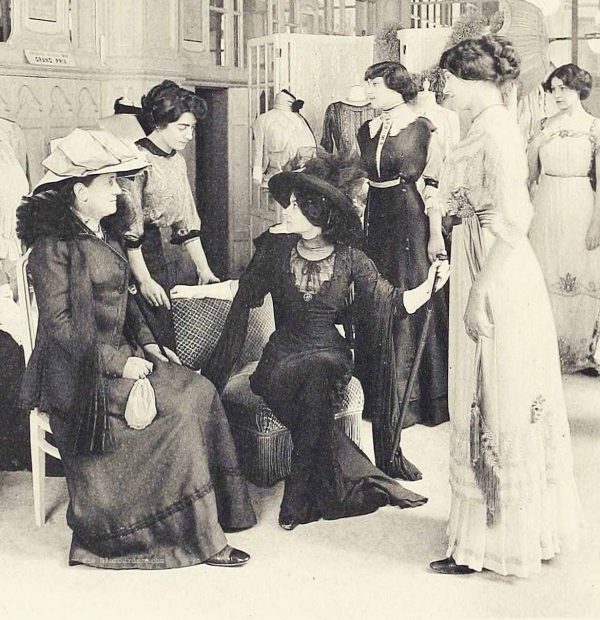
A Walk in the Woods – Paris c.1902 | AI Enhanced Film
In the 1900’s, if you were a fashionable young English lady of the social elite, you made a twice annual pilgrimage to Paris. There you would join other women from as far away as New York and St Petersburg.
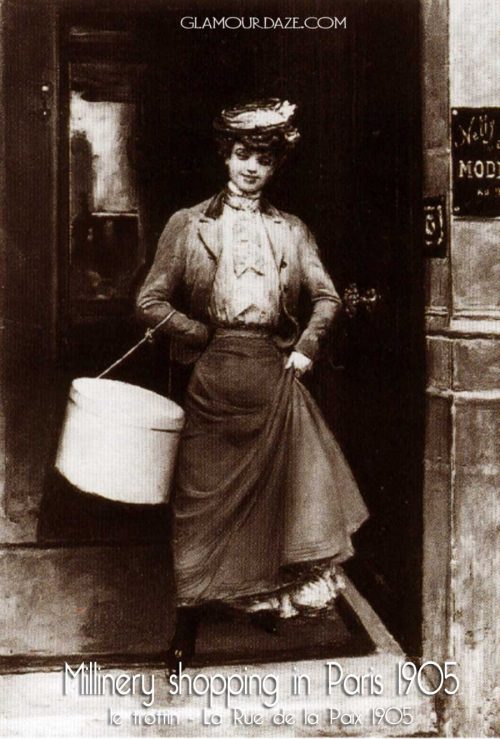
The Paris Fashion Pilgrims
During the months of March and later in September, droves of women were seen entering the studios found on the rue Halevy, la rue Auber, rue de la Paix , rue Taitbout, and Place Vendome.
In these often cramped shops, with seamstresses working feverishly in the backrooms, you would meet your own personal vendeuse, who would help you choose your wardrobe for the coming season.
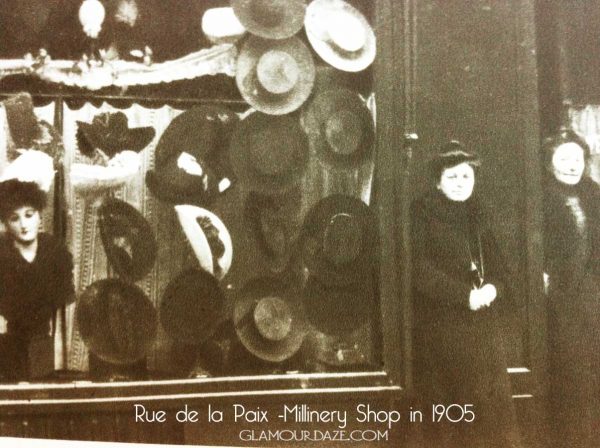
This woman was your ally and would know your darkest secrets, both personal and financial! The survival of these early fashion houses depended entirely on holding on to their wealthy clientele. It helped for them to know some of your little secrets!
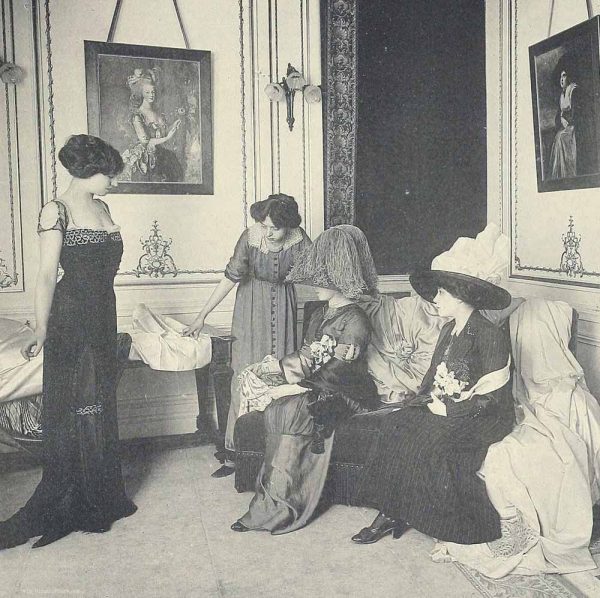
Armed with copies of Les Modes, you would browse through the latest works of the Grand Couturiers like Poiret, Worth, Callot Soeurs, Jeanne Paquin,Madeleine Chéruit and so on, for inspiration on how to outshine your friends, not to mention enemies!
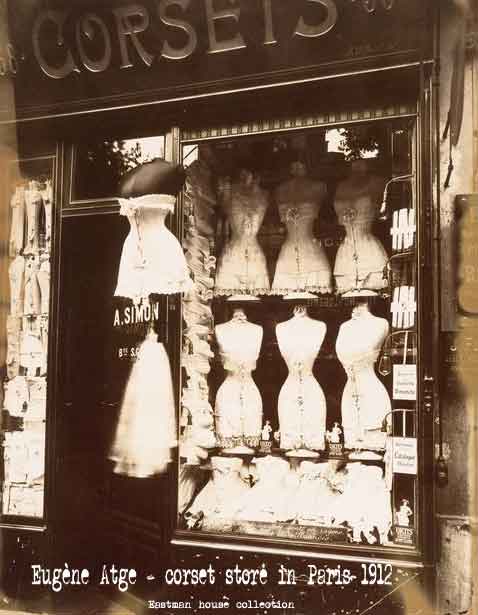
Fashion Illustrations
As the decade progressed, dreadful magazine depictions of static women, detailing every seam and stitch, were replaced with the new Art Nouveau style. Now they used the new photographic methods of illustration.

Together with your vendeuse, you would choose the following six months worth of wardrobe.
Lingerie, morning dress, afternoon dress, walking dresses, cycling combinations, costumes for traveling in a train or a motor car, evening gowns to lounge, a gown each for a special occasion, like Ascot, a wedding, theater. A list as endless as your purse allowed!
Dressing an Edwardian lady
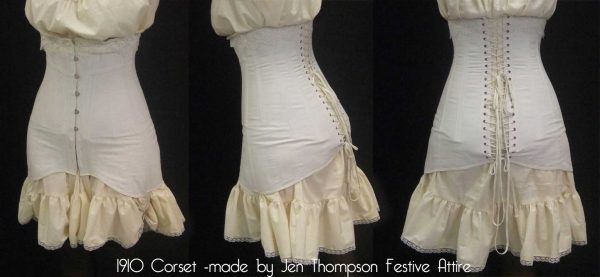
Underwear for Edwardian Ladies
Beginning with undergarments, your wardrobe would consist of several sets of lingerie – day and night chemises, drawers, knickerbockers and petticoats. An excellent source for extant pieces can be found at Knowlesville.
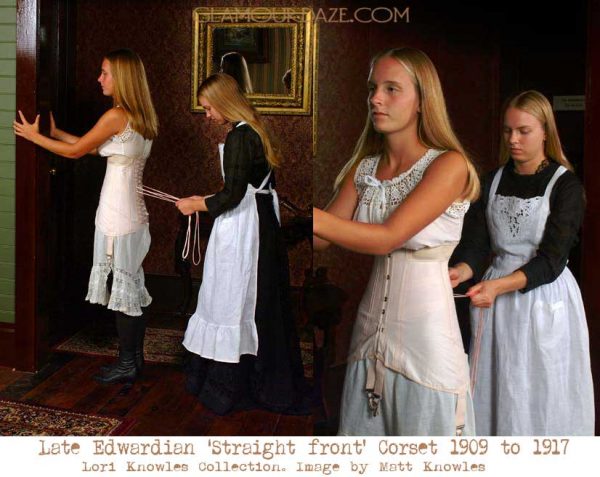
You would start your day by choosing your combination, and then be laced into a straight front s-curve corset. Over this you would wear a corset cover.

Edwardian Ladies Day wear
Next comes the first of your day outfits, usually a tailored morning outfit, which you could wear out for shopping or meeting a friend. This normally consisted of a smart blouse and a gored skirt combination, worn with a jacket during the colder months.

When you returned for lunch, you would change into your afternoon dress , which in summer time was often a colorful pastel affair.
Evening Dress
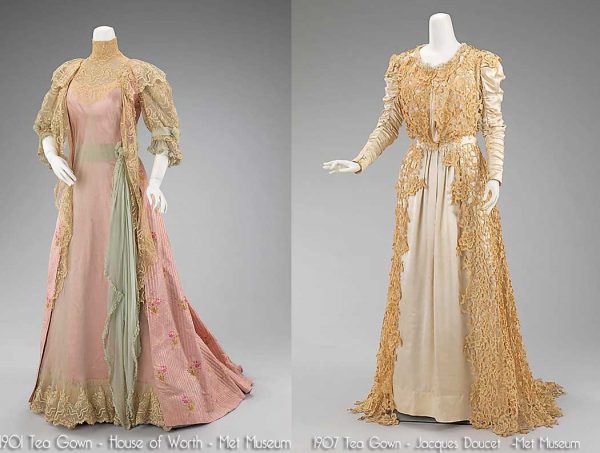
By 5pm you would then remove – with relief – your corset, and slip into a tea gown, for lounging in and receiving friends.
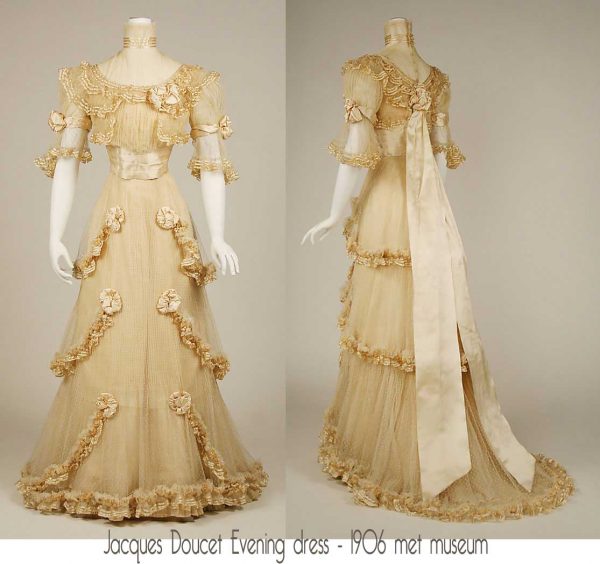
By 8pm you would put on your corset again, possibly a fresh change of lingerie. Then on went an evening dress, either for wearing indoors, or if the occasion demanded, for going to a special occasion.

By 1910, these gowns were increasingly becoming influenced by the works of Paul Poiret, whose eastern influenced satin and silk gowns were a favorite choice for the elite. The big hit for 1910 fancy dress evening wear in London were the harem pants!
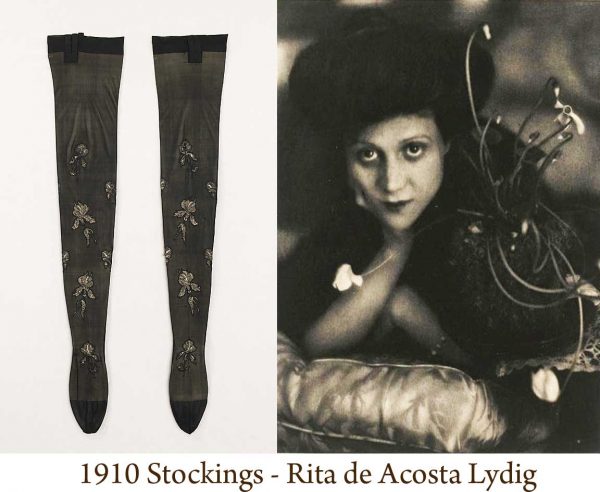
Throughout the day, you would also have changed your stockings at least twice – cotton for day, and pretty embroidered silk stockings for the evening.
All in all, it was a most time consuming occupation to be an Edwardian lady!
Edwardian Silhouettes – The Myth vs Reality
1900 to 1910
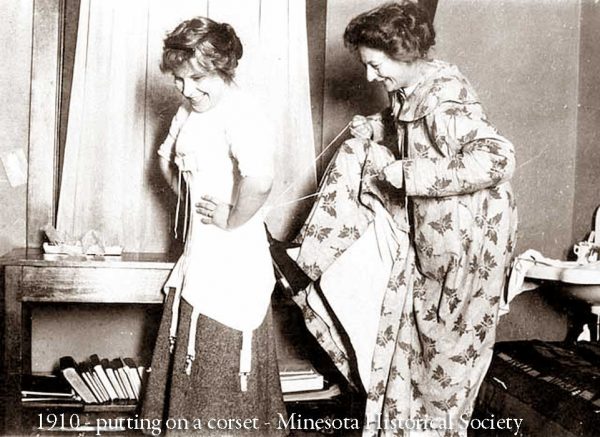
By 1900, any lady of good class – with the help of a lady’s maid – would have tied herself, daily, as her mother and grandmother had done, into restricting, and depending on your girth, suffocating boned corsets. The modern perception is of a woman’s digestive organs being pulled in to tiny circlets of 20 inches or even less. If that sounds painful – it certainly would have been . Perhaps this explains the sale of smelling salts during this era.
The S-bend or S-Curve Corset

The Edwardian corset of choice was the ‘abdominal’ or ‘straight-front’ corset.
Promoted by corsetiere and medical doctor Josephine Inès Gaches-Sarraute in her 1900 book Le Corset. Prolonged wear of the hourglass corset was known to leave a protruding abdomen issue for older women.
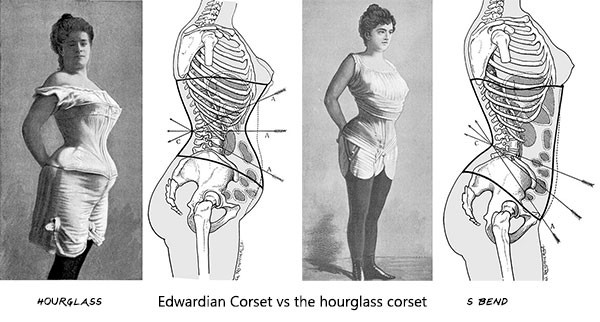
Many corset designers produced versions of the abdominal health corset between 1900 and 1914. The debate of whether corsets were good or bad for women’s health is addressed in a 1908 book by Weingarten Bros. This Edwardian corset book which promoted the WB corset is a great find for enthusiasts.
The Corset evolves
1908 to 1914
In her article S-bend Corsets in Context, Marion McNealy of Foundations Revealed suggests comparing illustrations to photographs of everyday women in the 1900’s. The actual effect of the straight front or s-bend corset,was an ostensibly erect posture. Most women laced them more loosely.
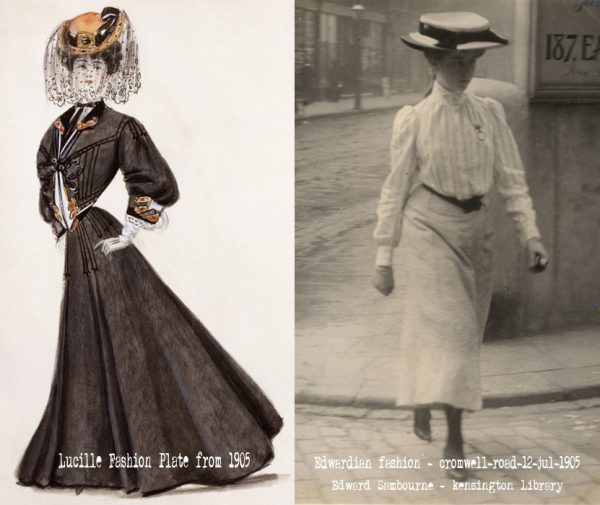
My take on those old fashion plates, as in today’s fashion illustrations, is that there is a tendency to exaggerate the lines. Compare a Lucille fashion plate from 1905 to the beautiful photo by Edward Sambourne of a young lady in London that year.
The Gibson Girl Silhouette
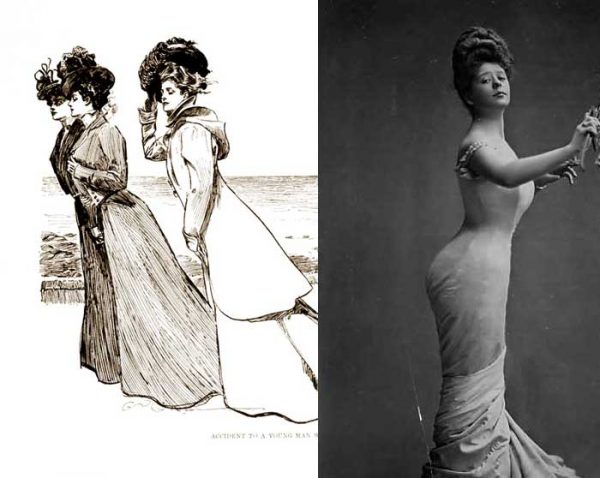
Rather it was an idealized vision of Edwardian women at the time, popularized by the illustrations of Charles Dana Gibson, and the postcard images of Gibson Girl Camille Clifford, that has left us with a rather extreme vision of an Edwardian woman’s shape.
In Defense of Corsets
Valerie Steele, curator of the Fashion Institute of Technology, in an interview with the excellent Lisa Hix of Collectors Weekly gives an authoritative opinion on corsets.
“Women rarely reduced their waists more than 1-2 inches. Worn with a gap in the back, the woman’s corseted waist measured between 22 and 26 inches.”
“The S-bend corsets did force women to tilt awkwardly, hips back, breasts forward. This created the exaggerated S-shape in the back. But there is no medical evidence of misshaped livers”
But between 1908 and 1914, corset designs began to favor a more natural shape. The move was “away from the Venus ideal” and towards the “Diana ideal – a slimmer and more athletic silhouette.”
Modes in Dress – 1900 and 1909
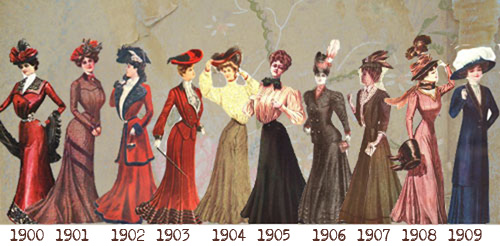
Women took to wearing more tailored jackets, worn with long skirts [ and a slight raise of the hem ] and high heel ankle boots.
The silhouette moved gradually along a decreasing s-curve from 1901 to the Empire line by 1910 . Common colors for Edwardian women’s day-wear were combination two tone affairs of pale tops and dark skirts.
The fabrics employed were linen [ if you were poor ] cotton [ if you were middle class ] and silks and high grade cottons [ if you were upper class].
With detail, as in all styles in the Belle Epoch, laced trims and attentive detail was a signal of a girls social status. Plenty of shoulder and waist trimmings, with applique on skirts and dress.
The 20th Century Woman
Women, especially of the new middle class, began to have more social freedoms. It became common for women friends to travel together abroad on cycling trips – to the Alps for instance, or to Italy, as was beautifully portrayed in the Merchant ivory film ‘ A Room with a View‘ , an E.M Forster story published in 1908.
Edwardian Clothing in Detail
The popular Day Outfit combination was the matching of a high necked white or pale cotton blouse with a dark tight fitting A-line gored skirt, reaching from the ankle to just below the bust. Some skirts were also stitched in corselet fashion from the waist to below the breasts. This simple sporty blouse and skirt style first appeared in the late 1890’s.
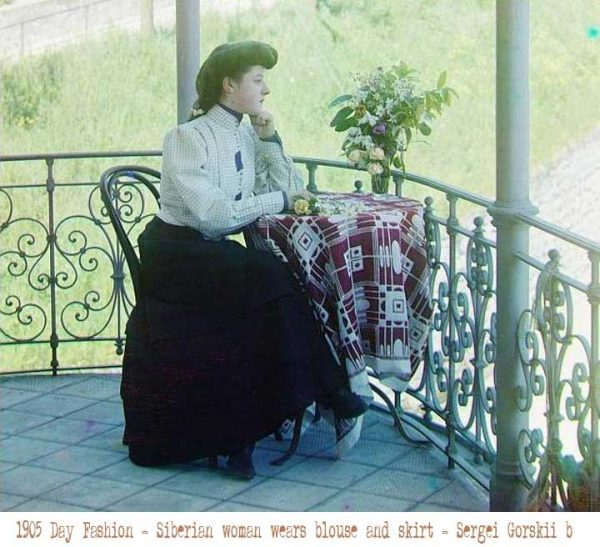
Edwardian Skirts
Skirts often had one single seam, and the result was a pleasing shapeliness that added contour to the most unpromising figures!
Hemlines went to the floor, with a hitch facility for entering carriages. By 1910 – the hem began to lift to just above the ankle. The blouse silhouette began with puffed shoulders but by 1914. The shoulders were much slimmer – which in turn added more roundness to the hips.
Outerwear
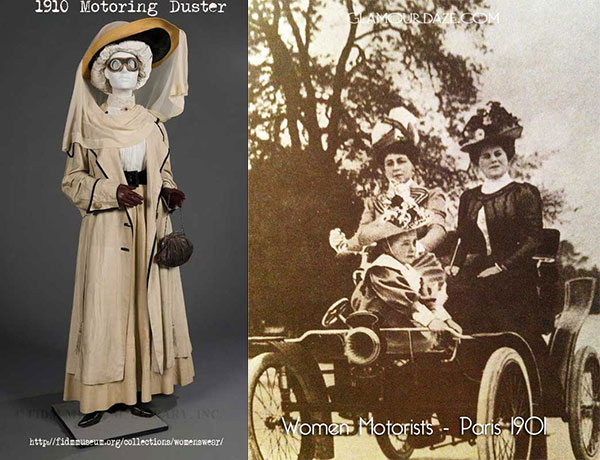
By 1905, with the increasing popularity of the automobile, the fashion conscious woman began to seek pretty manteaux automobiles or car coats for the autumn and winter.
These coats were highly fashionable, cut straight from the shoulder to about fifteen inches below her waist. When worn with the new short skirts that barely reached the ankle, a woman could cut quite a figure when out for a spin! If it was a wet or snowy day, you might also wear a duster over your whole costume, to keep the mud and grime off your clothing.
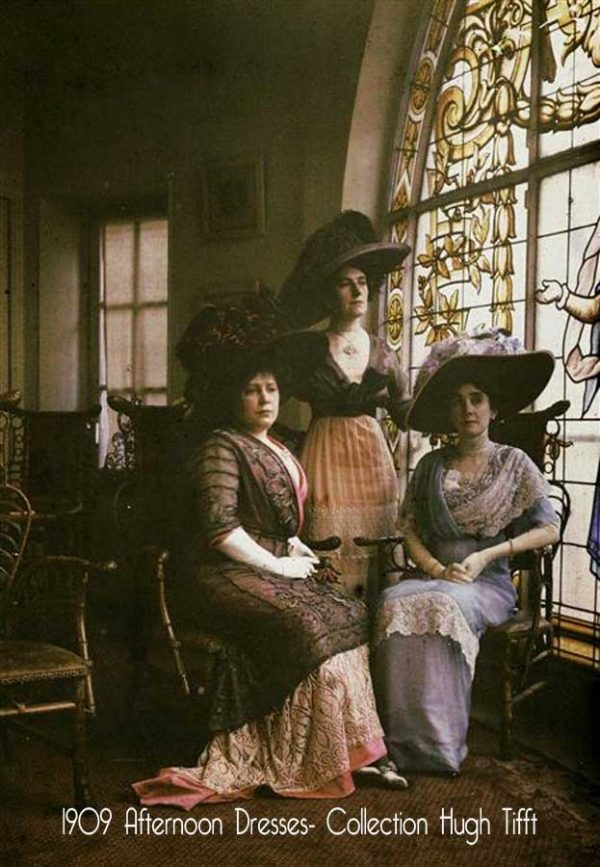
Afternoon Dress styles, though in highly colorful pastel shades and lots of applique detail, remained fairly conservative during the 1900’s. They were often worn to formal luncheons, meetings, and conservative female gatherings – the dress code of which was under the control of a girls more Victorian minded mother!
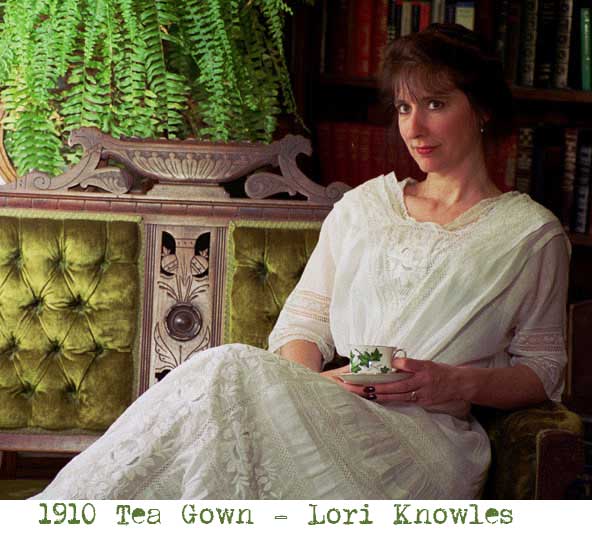
Tea Gowns – usually donned by 5pm, if a woman had returned home, were delightful affairs. Often white cotton and extremely comfortable. She would often entertain her friends wearing a tea gown, as she could afford to be fairly informal.
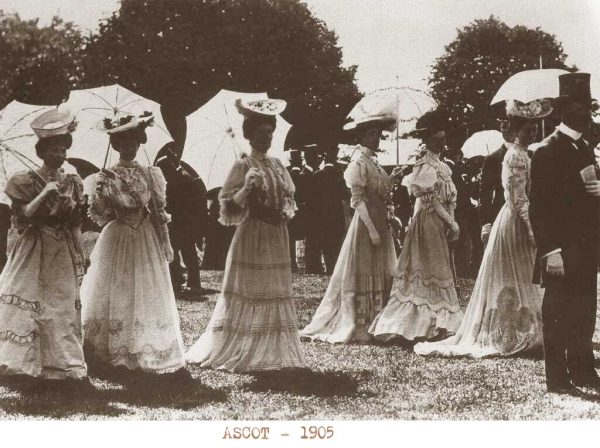
In Edwardian Britain, the age old London Season, running from February to July, allowed women the opportunity to display their very best Paris acquisitions.
From the opening of Covent Garden to the Royal Drawing Rooms, to private balls and concerts, and to Ascot Royal Enclosure, the very latest, the best and the worst in fashions were displayed by the social elite.
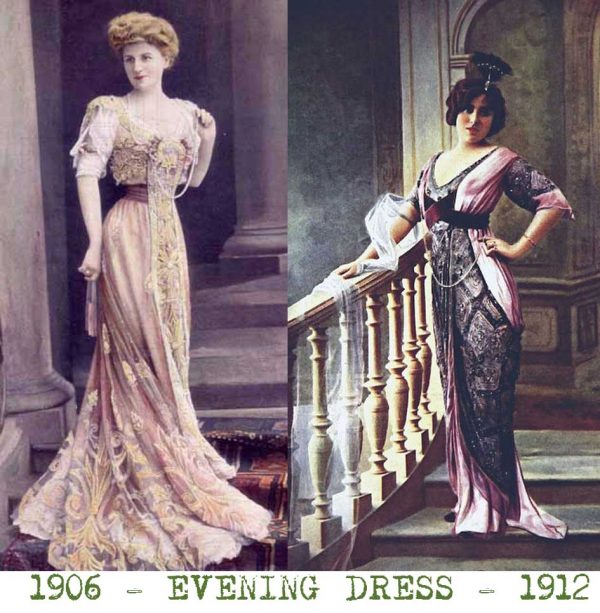
Evening dresses in the Edwardian era were flamboyant and provocative, with low cut bodices allowing an overt display of jewelry and bosom! Evening frou-frou in the 1900s meant luxurious sensual fabric . By 1910 women were growing tired of bulky evening dress, and in particular, French women began to remove the trains from their dresses and embrace the new Empire lines, especially Poiret’s Ballet Russes inspired creations.
Changes in Mode
In 1909, as the Edwardian era came to a close – a strange fashion fad briefly appeared in the form of the hobble skirt . Credited by some to Paul Poiret, though no one seems to have wanted to claim credit at the time!
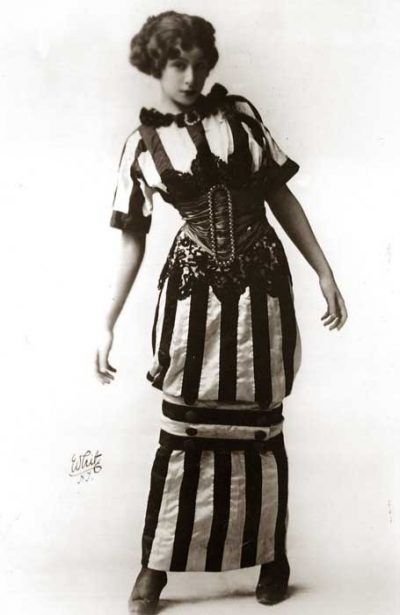
The hobble skirt effectively clamped a woman’s knees together and made movement of any kind a difficulty. Combined with the increasing vogue of wide brimmed hats [ in some cases up to three feet! ] popularized by Lucille – Poiret’s main American competitor, it seemed as if fashion had lost all reason by 1910.
Hairstyles and millinery
1900 to 1918.
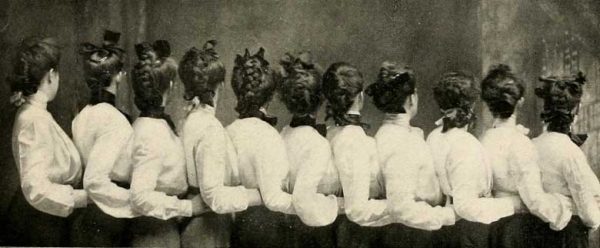
Hairdressing now received a lot of attention in the fashion magazines of the time. The most popular coiffure were Marcel waves arranged in “pompadour” styles, for it was one of the quickest methods in dressing your hair. In 1911 the 10 minute pompadour was the most popular!
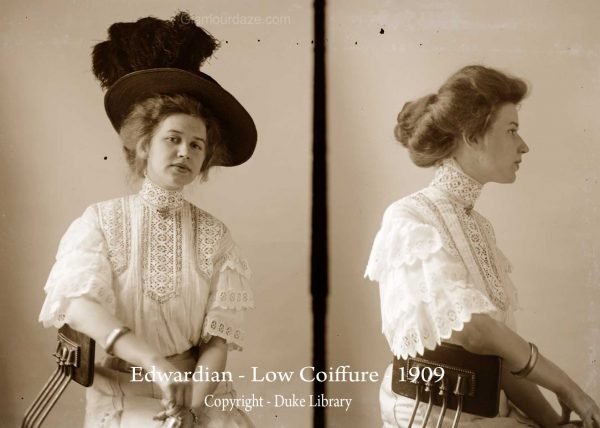
These hairstyles supported an astonishing array of large hats. They went out of their way to out shine the hair upon which they were pinned!
By 1910 the pompadour gradually evolved into a low pompadour, which by the advent of the First World War,had simplified into a simple chignon hairstyle, with hair gathered in a loose bun at the back, or nape of the neck.

To compliment this new hairstyle, hat crowns were lower, nestling neatly on the bun. The wide brims and audacious plumes of a few years earlier were gone. Wartime morals frowned on such things.
The Ballet Russes in 1909
Paris was by 1900 the leading fashion centre of the world and the houses of Worth, Callot Soeurs, Doucet and Paquin were the leading names. High fashion or Haute Couture was the name of the game, using the costliest fabrics and marketed to the wealthy elite of Paris, London and New York.
However the style was essentially the same – the Empire line and Directoire style , with high waist and linear lines being the favored look, with pastel colors such as eau de nil, rose pink and sky blue resembling a sort of in club look to tea gowns and evening dresses.
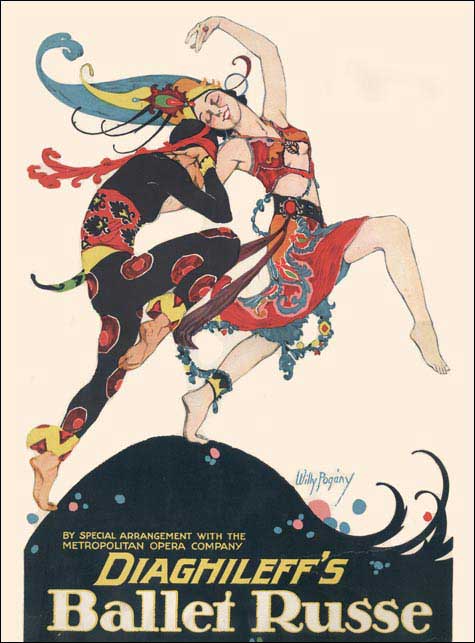
It was through the ascendancy of the Art Decoratifs styles from the Art Nouveau movement, and the arrival of the Ballet Russes – first in 1906 as an exhibition organized by founder Serge Diaghilev and then in 1909 the explosive performances of the Imperial Russian Ballet, with its exuberant eastern inspired costumes designed by Leon Bakst, that the winds of change really stirred.
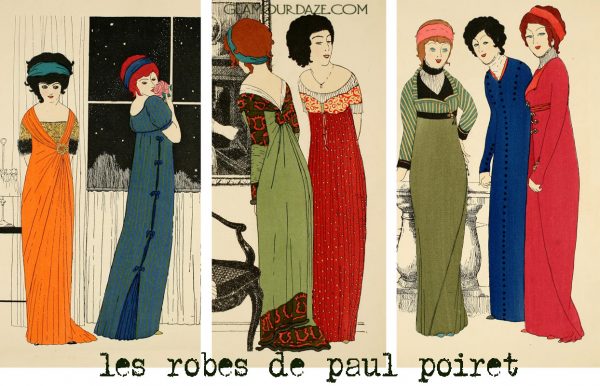
Dancer Nijinskys harem trousers caused females to gasp, and recognizing the potential – Paul Poiret – the master of opportunism, produced his harem skirt. It became for a time quite popular among the bright young things of the British upper classes. Poiret, inspired perhaps by Bakst illustrations seen in 1906 – had recognized the need for more expressive illustrations for his designs.
He engaged an unknown Art-Nouveau illustrator Paul Iribe to illustrate his Les Robes de Paul Poiret in 1908. The impact this alone had on the merging of fashion and art cannot be underestimated. The two went hand in hand for two decades after that.
The Advent of Modern Fashion – 1912 to 1919
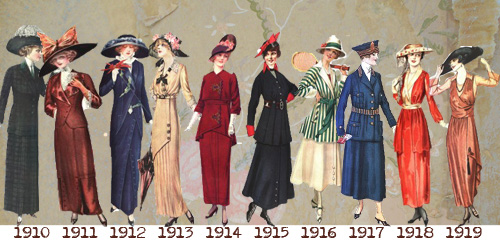
By 1912, the silhouette had achieved a more natural line. Women wore long line corsets as foundations for day dresses which were tight fitting and flattering .
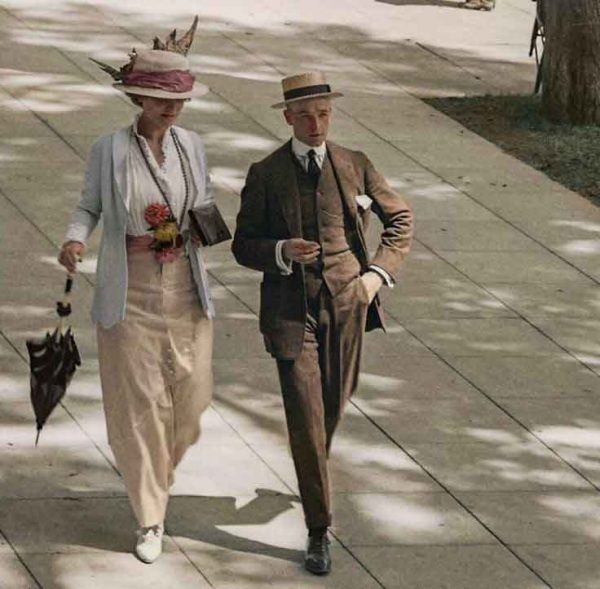
In 1914 there was a mercifully brief popular drive in Paris. Period style fashions, replete with bustles, hoops and garters! Most of the big fashion houses – Poiret included, had a flutter on them . But the drive for change was unstoppable. By 1915, with a bloody war in full swing in Europe, Callot Soeurs, showed a brand new silhouette. A straight un-girdled chemise hanging over a straight foundation.
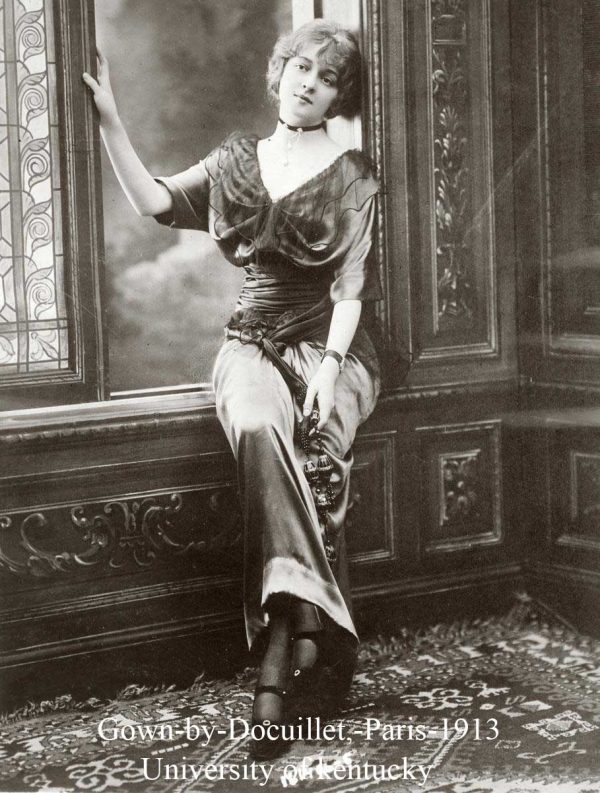
One other interesting development in the early war years, was the introduction of a matching colored blouse. The first step towards a day wear style which was destined to become the staple for a woman’s day suit.
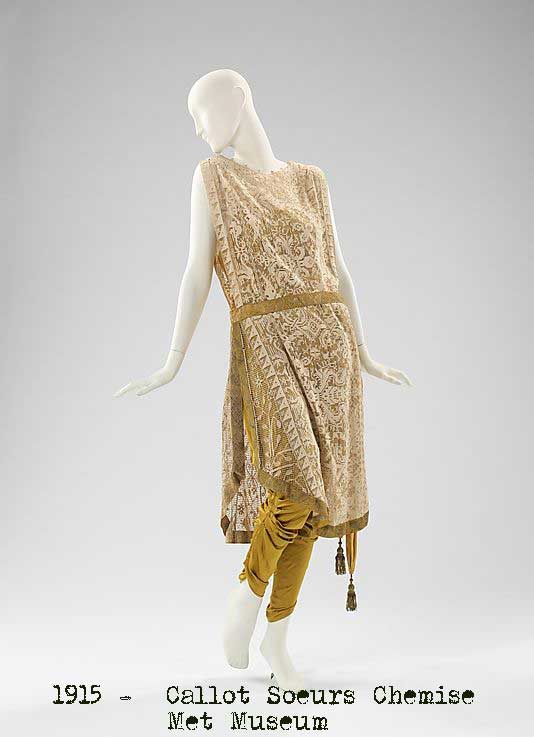
Coco Chanel and the New Style
Coco Chanel adored this basic shift or chemise dress style and with her fondness for the popular American Jumper or Middy blouse [ a blouse that hangs from shoulder to below the waist and tied with a loose girdle belt ] – she adapted the local Jersey jumpers worn by sailors in the fashionable sea town of Deauville ( where she had opened a new store ). Chanel created a woman’s cardigan, with distinctly casual belts and pockets that was to herald the 1920s fashion look some five years before it became the norm.
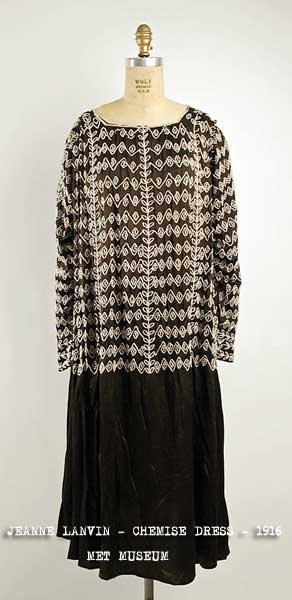
Like Chanel, the designer Jeanne Lanvin, who in this period – specialized in young girls wear – loved the basic simplicity of the chemise, and began to create summer shift dresses for her customers which was to herald a breakaway from restrictive dresses.
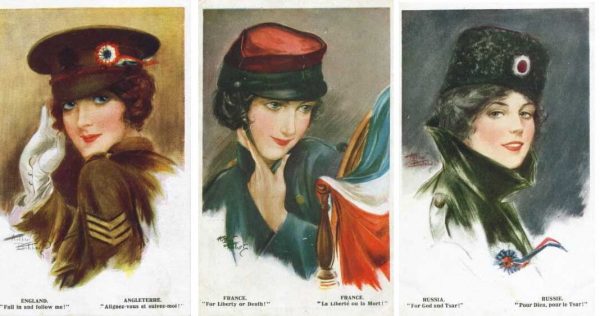
The Impact of War on Fashion
The outbreak of The First World War in 1914 did not stop the usual Paris collections from going on display to large international attendance, but despite attempts by American Vogue’s Editor Edna Woolman Chase, to organize charitable events to aid the French fashion industry, there was understandable worry in Paris. America was going to benefit one way or the other as competitors. If you are lucky enough to own vintage French fashion periodicals of the time like Les Modes – and La Petit Echo de la Mode, the war is seldom mentioned.

But the war was everywhere and women’s dress, as it it did in the 1940s, by necessity, became more military.
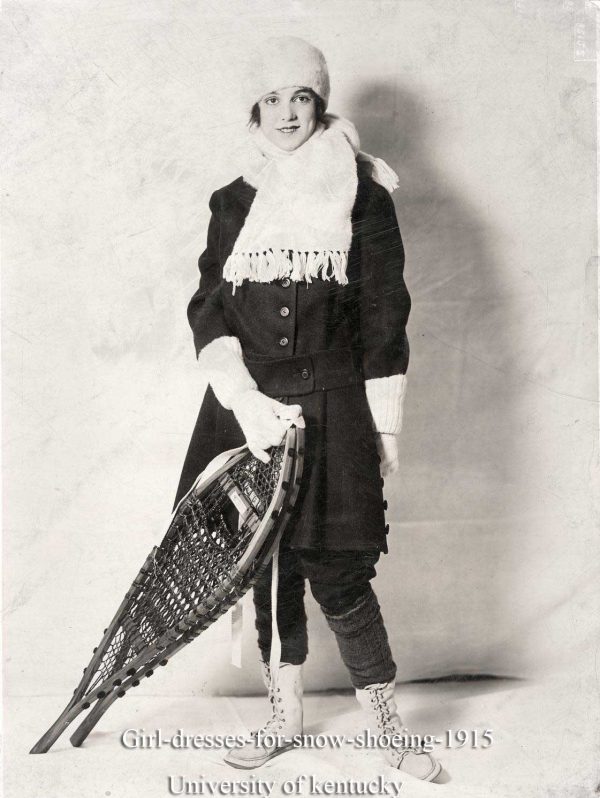
Clothing became sensible. Tailored jackets, trench-coats and breeches cut a particularly feminine shape on women serving the war effort. In Britain women joined the Voluntary Aid Detachment [ VAD] and Queen Alexandra’s Royal Army Nursing Corps. In the USA, the Marine Corps Women’s Reserve, not to mention the special Women’s battalions on the Russian Front.
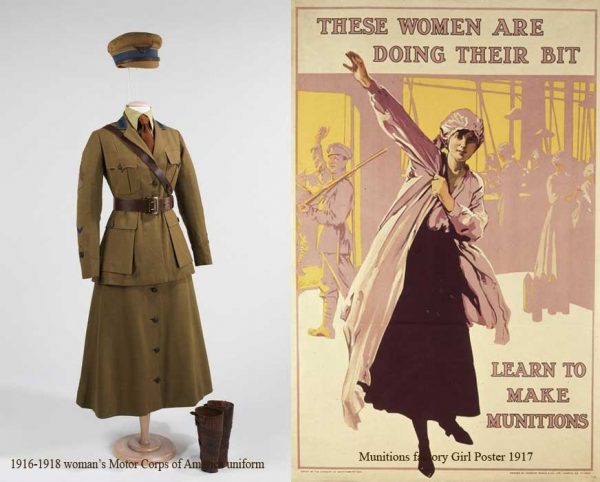
The ‘military groups’ were reserved for upper class women. However the munitions factories on all sides made plentiful use of working class girls.
With all this shake up of the social classes, rich and poor, men and women alike mixed like never before. From this melting pot grew an emancipation in women’s dress.
1915 to 1919 – A New Silhouette
This was the era of the Art Nouveau styled figure.
The emphasis in women’s lingerie was to move away from molding her body to supporting it. The traditional bodice evolved into the brassiere, which became integral for the now more physically active woman. The first modern bra is credited to Mary Phelps Jacob, which she patented in 1914.

The popular high Empire waist replaced traditional bodices,with pretty cummerbund-style sashes. Fabrics included natural silks, linens, cottons and wool. Also the new artificial silk – rayon, out of which came the popular yarns like serge, gabardine (wool) , organza (silk) and chiffon (cotton, silk or rayon). Jersey and Denim began to creep into new leisure wear thanks to young designers like Coco Chanel.
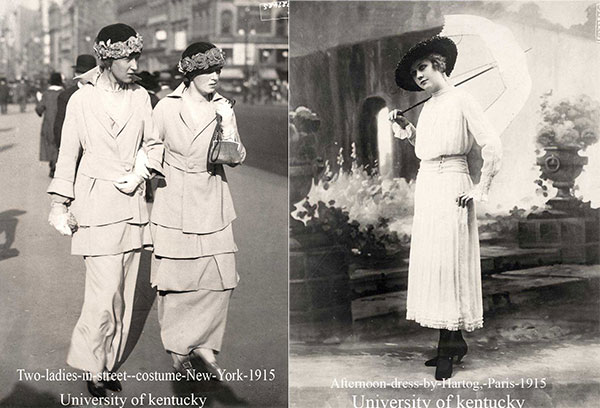
1910’s dress designs had a horizontal layered look. Alternatively, vertical wraps such as Poiret’s popular Kimono coats, hung over tailored skirts and jacket sets. Hems hung just above the ankle in daytime. Generally floor level in evening dress, they began to creep up in some designs as the 1910s progressed.
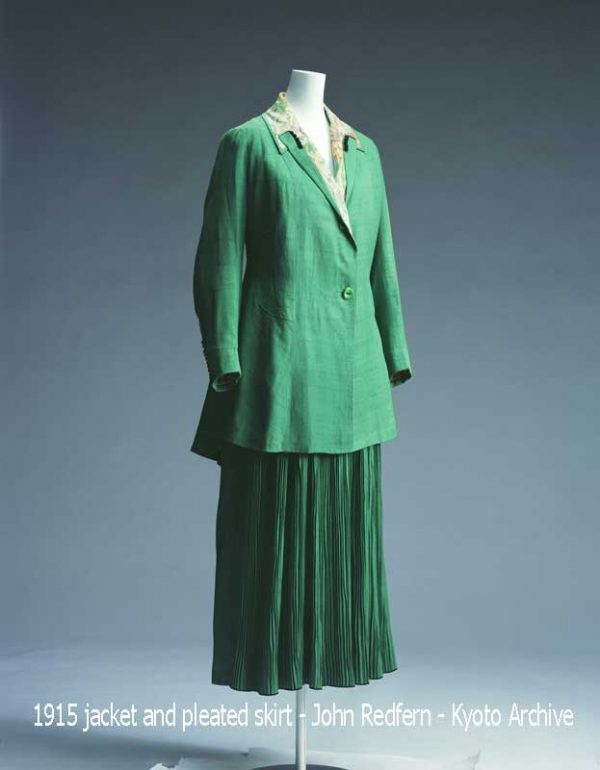
By 1915 a new silhouette began to appear with a ‘new line’ of flared skirts, ( known to some as war crinolines) raised hemlines and subsequently more visible and fashionable footwear appeared. Lace up heeled boots were a pleasing addition to winter modes.
Beige and white joining the usual black or brown colors! As the war progressed – evening wear all but disappeared from collections and the tea gown vanished altogether.
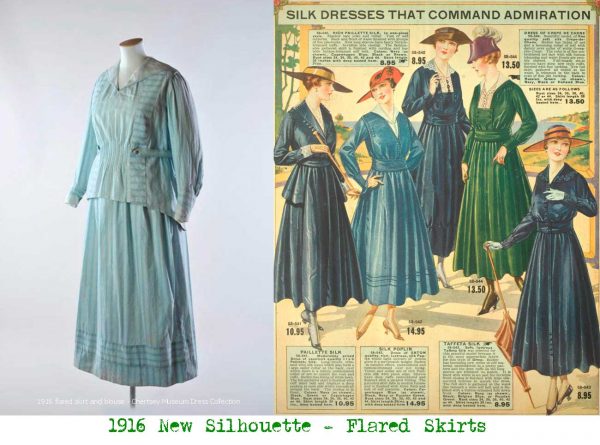
The Swimwear Revolution

Edwardian Swimsuit designs slowly shook off social mores , with women’s legs gradually appearing at the beach, albeit clad in stockings.

With the notable exception of the Australians, and in particular Australian swimmer Annette Kellerman, who was somewhat of a swimsuit revolutionary, bathing costumes between 1900 and 1920 changed only gradually.
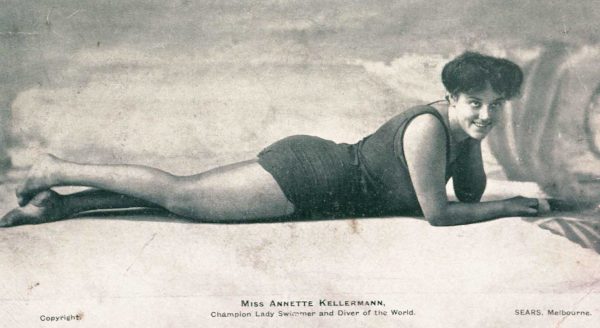
Kellerman had caused a bit of a stir, when upon arriving in the USA. She appeared in a tight body hugging swimsuit. It got her arrested in Massachusetts for “indecent exposure.” The trial was a turning point in swim suit history. It also helped sweep away the Victorian standards that had incarcerated her.
Kellerman set the look for the Max Sennett bathing beauties and the standard for the sexy Jantzen swimsuit designs which came later.
The Birth of the Flapper look
It is tricky to determine accurately the arrival of the flapper look. The origins of the gamine drop-waist style which was to become the norm by the 1920s. The excellent Fashion since 1900 – draws attention to a mother and daughter design by Jeanne Lanvin from 1914.
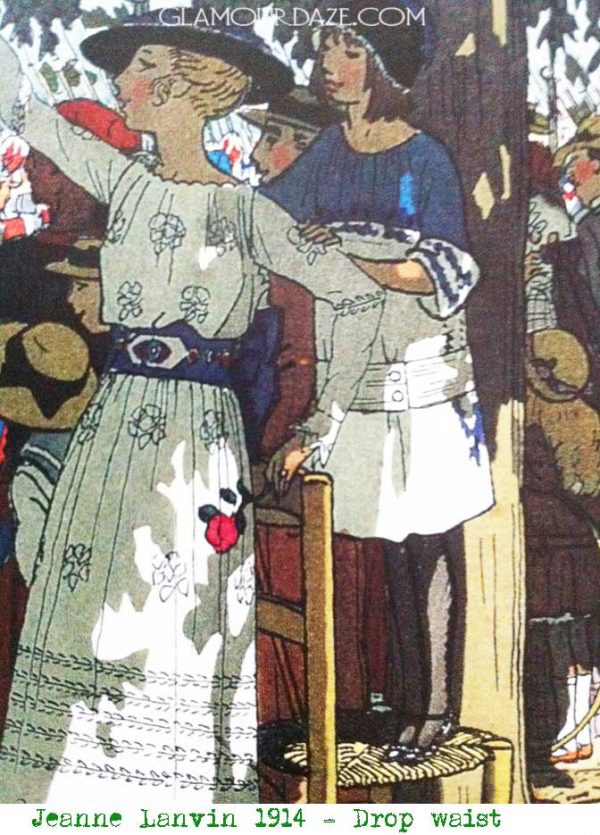
The Waist Heads South
Look closely at the daughters little boxy dress. It has a drop waist. You see the flapper dress look that was to dominate some years later!
Black was a common color during First World War, and the diminutive Coco Chanel chose to make the most from this and other neutral colors and of wartime dress modes.
With Chanel’s fondness for simplicity – as early as 1916 in Harpers Bazaar, a Chanel design showed a chemise dress with a belt detail that is definitely drop waist!
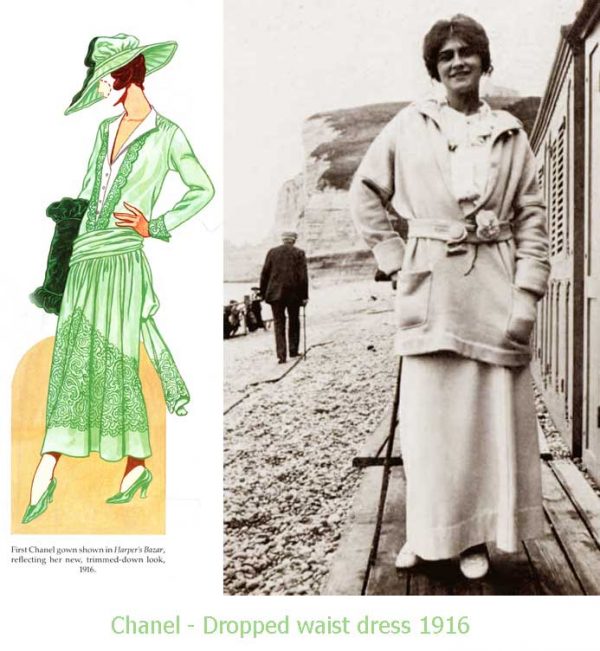
Her love for more sporty and casual dress spread in viral fashion from the seaside town of Deauville – where she had opened a shop – to Paris, London and beyond. In 1917 Harper’s Bazaar said “Chanel’s name is on the lips of every buyer.”
Conclusion
Paul Poiret’s star began to wane after the outbreak of war ( he had been drafted). When he returned in 1919 with many beautiful designs in the new silhouettes, his name no longer elicited excitement.
He had a chance encounter with Coco Chanel in a Paris street in the 1920’s. Poiret asked,“For whom Madame, do you mourn?“. Chanel was wearing her trademark black colors.
Chanel replied ” For you .. my dear Poiret!”
© 25/09/2013 Stevie McGlinchey
Further Reading:
History of Fashion – 1920 to 1929
A Short History of Fashion – 1900 to 1969
A Concise History of 1940’s Women’s Fashion – 1940 to 1949
Bibliography | Further Reading and Image sources:
The Golden Age of Style -Julian Robinson.
Foundations Revealed.
Les Robes de Paul Poiret.
Fashion since 1900 – Valerie Mendes and Amy de la Haye.
The History of Feminine Fashion.
Knowlesville Vintage.
Festive Attire.
Everything you know about corsets is false.
Les Createurs de la Mode
Photo Detective.

